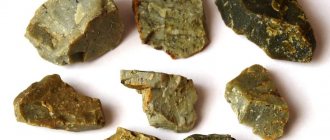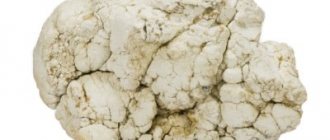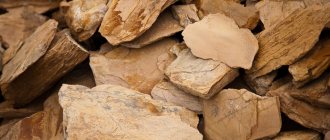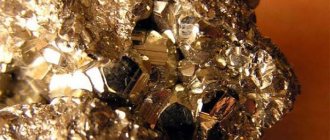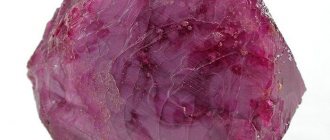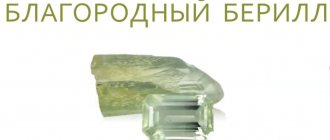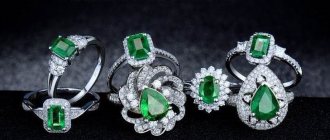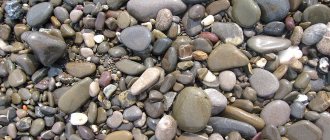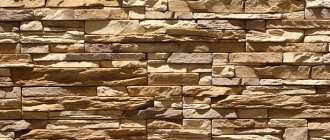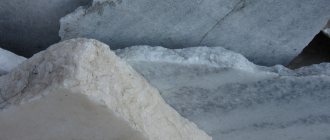| Category | Clastic rocks |
| Title in English | Argillite |
| Formula | Mg2Si3O8*2H2O |
| Group | Clay rocks (pelites) |
| Color | Black |
| Stroke color | Black |
| Shine | Matte |
| Transparency | Opaque |
| singonia | To be confirmed |
| Hardness | 3,5 — 4 |
| Cleavage | Perfect |
| Density, g/cm³ | 1,3 — 2,6 |
| Kink | Conchoidal |
| origin of name | The name is derived from the Greek words “ἄργιλλος”, which translates as clay and “λίθος” - stone. |
| Morphology | Mudstones form massive platy varieties of rock under natural conditions. |
Mudstone is a hard, rock-like clay rock that forms when water compacts and evaporates from clay. Mudstones are distinguished from the latter by their greater hardness and inability to soak in water. The composition of the mineral is based on hydromicaceous clays, montmorillonites and chlorites, the admixture of which is quartz, mica, and feldspars. Mudstones occur as massive beds or microlayered platy varieties in areas that have been exposed to high temperature and pressure.
Mudstone deposits
Argillite deposits are distributed throughout the planet, but the main deposits are considered to be on the Queen Charlotte Islands (Canada).
Large mines are also known in Russia, Ukraine, Estonia, Central Asia and China. — Advertising —
Mudstone rocks are mined in open quarries using excavators. In this case, the entire rock, without dividing it into different layers, is mined in a total volume and sent for processing. When extracting mudstone from hard rocks, such as shale, blasting must be used. For this purpose, deep wells are drilled into which explosives are placed. The top blasted layer is then removed, and the development of the next one proceeds. The advantage of such hard rocks is that they can be mined all year round. In cold and humid weather, loose rocks are quickly saturated with moisture from the air, making their extraction and transportation difficult and very costly.
Main Differences
Despite their similarities, differences between siltstone and mudstone influence the distribution and use of stones. Initially, the minerals were not identified as separate. The siltstone was mistaken for sandstone or mudstone due to the varying percentage of sand in the composition. To distinguish these rocks, take into account the following features:
- The ratio of composition elements. Petrified flour contains more sand. Mudstone sometimes contains coal.
- Reaction to water. The siltstone gets wet, losing its original appearance. Zebra stone does not absorb moisture.
- Size of silicate grains. In argillite, the granularity is less pronounced.
A common way to find visual differences is to look at the average grain area. For accuracy, it is recommended to select samples of similar size. Siltstone is also distinguished by its shine.
Both stones are clay that has dried out and petrified over time and contains impurities. The difference between mudstone and siltstone lies in the amount of sand, which affects the strength of the mineral. Despite the inconspicuousness of most samples, among these rocks there are representatives of saturated colors with sharp tints of color, as well as bright shine. Such minerals can become beautiful jewelry or decorative elements.
History of mudstone
“Argillite” got its name from the Greek language, it is translated as “clay” and “stone”.
The stone is also known under other names, such as zebra, mud, hailite. One variety of mudstone, called catlinite, was popular among the Sioux Indians, who made peace pipes from it. And now the quarries in Pipestone have retained their cult significance and they still continue to mine catlinite there.
Physico-chemical characteristics of argillite
According to the chemical composition, mudstones belong to stone-like shale clays. The color palette of the mineral includes bluish-gray, black, slate, light, and whitish shades. The mineral is characterized by the presence of a silky or resinous sheen. Hardness on the Mohs scale is 3.5-4.0. Density from 1.3 to 2.6 g/cm3.
Rock characteristics
The mineral belongs to the type of sedimentary formations; its composition is formed due to rocks destroyed under the influence of external factors under the influence of temperature and pressure. The main deposits are located in Canada and the Queen Charlotte Islands, and on the European continent in Estonia.
Argillite, unlike clay, has greater density, hardness, and does not get wet in water. It can be white, black, slate in color, less commonly red, and has a resinous, silky sheen.
The composition of mudstone is formed by:
- clay minerals (montmorillonite, chlorite, hydromica);
- quartz;
- mica;
- feldspars.
Argillite, unlike clay, has greater density, hardness, and does not get wet in water.
In nature there are massive layers of mudstone or slab formations. The name of the mineral corresponds to the words of Greek origin for clay (argillos) and stone (lithos). There are known synonyms that define the name of the mineral:
We also recommend reading:
The history and curse of the Kohinoor stone The marvelous ametrine stone Characteristics of larimar and its main properties Selection of stones by date of birth
- mudstone or mud stone (characterizes small particles of minerals that form the composition of the rock);
- chailite (dark gray);
- zebra stone (defined by the appearance represented by alternating bright and light stripes, reminiscent of the skin of a zebra).
Types of mudstone
— Advertising —
There are several varieties of argillite:
- zebra - a layered variety, painted in contrasting tones;
- mud - a very abrasion-resistant subspecies;
- Hailite is a dark gray stone mined in British Columbia.
Description and external signs
Argillite is a type of rock-like clay that is insoluble in water. The name comes from the Greek words rgillos and lithos, which mean “clay stone”. People often call it mudstone from the English. mud - “dirt”. Like clays, mudstones form either massive beds or tabular varieties.
This mineral is a dense rock cemented by overlying strata. It is located at a depth below 1500 m. There is also the term “mudstone-like clay”. They lie approximately 300 - 700 m from the earth's surface. They differ from other clays in that they get slightly wet and crack when dried.
The color of mudstone is most often dark – gray with a blue tint or black tones. But there are also white minerals with a greenish, brown, pink tint. Their surface is resinous, smooth, and shiny.
The magical properties of argillite
In magical circles, mudstones are known as "stop stones." This mineral is able to stop a wide variety of processes and stop the rapid flow of energy. For this reason, talismans and amulets made from argillites are recommended exclusively for hyperactive people. But at the same time, mudstones are not destructive minerals; they resist active actions, but help in contemplative concentration. With their help, the thought process becomes deep, insight increases and it becomes easier to understand the essence and meaning of current events. Argillite amulets also have the ability to transform insight into a real gift of clairvoyance.
Scope and scope
Argillite is, for the most part, an ornamental stone, which is quite widely used in the following areas:
- Ceramic parts, cement, and fire-resistant materials made from argillite are actively used in construction. This mineral is not used in its pure form in construction work, because has a loose structure.
- Foundries use it in the production of paper and rubber.
- In the field of purification of water and oil products, a carbonaceous variety of the mineral, which has absorbent properties, is actively used. In everyday life, pink mudstone crumbs are widely used, which can purify water from unwanted impurities.
- One of the ways to decorate walls or ceilings when decorating an interior is to use argillite chips, which create a heterogeneous texture that looks very original.
- Certain types of stone are used to make handmade items. Processing argillite is a rather labor-intensive process, so products made from it are rare and quite expensive.
Who is suitable and not suitable according to zodiac sign
According to astrologers, argillite is best suited for representatives of the Air element, especially Gemini. It helps them effectively restore physical and emotional balance. For Water signs, wearing this stone as a talisman will help improve relationships with people around them, but Pisces runs the risk of plunging into apathy, because... this sign, in itself, is calm and prone to self-reflection. Earth signs can use the stone to prevent illness.
It is contraindicated to wear argillite for fire signs - it can attract troubles and illnesses to them!
Medicinal properties
Argillite has a beneficial effect on the liver, adrenal glands, kidneys, pancreas, spleen and men's health. But the peculiarity is that it does not eliminate an existing disease, but only prevents it. If the disease worsens, wearing this stone will only worsen the condition.
Lithotherapists recommend using the mineral in powder form. It was in this form that the American Indians used it as an antiseptic. Argillite baths improve peripheral blood circulation, relieve muscle spasms and inflammation, and accelerate metabolism. Compresses with mineral powder help restore connective tissue.
The stone is considered a strong talisman against addiction to alcohol. People who have a tendency to drink are recommended to wear it on themselves to reduce the craving for alcohol.
Magic properties
It is better to keep products made from argillite at home as a talisman against evil spirits and diseases. Even in ancient times, the Indians used stone precisely for these purposes.
Argillite is considered a talisman for astrologers, fortune tellers, sailors, and travelers. It is capable of accumulating cosmic energy and transmitting it to its owner, showing the right path. Even an uncut stone is suitable for this. It is better for psychics to have a whale figurine made of such a mineral as a talisman - this animal is considered a conductor between two worlds, it was revered by the Indians: through it they turned to the spirits of their ancestors for help.
The mineral also helps its owner receive a prophetic gift, thanks to its mystical connection with the Moon. If you wear it on yourself during the right lunar phase, you can learn to understand the language of nature or gain the ability to clairvoyance.
This stone is a reliable protector against love spells and the evil eye. It also strengthens the nervous system and warns the owner of danger. But its peculiarity is that as a talisman it is suitable exclusively for open, sociable people.
In introverts, it can provoke even greater immersion in oneself, a depressive state.
Decorations
Argillite is not classified as a precious or semi-precious stone, for this reason it is rarely used to create jewelry. American and Canadian Indians created figurines from it and used them as talismans. For almost 200 years, the Haida Indians have been known as black mudstone carvers, creating unique dishes, pendants, and figurines of totem animals. These works are not easy to acquire. The solution is to find them through online auctions or buy them directly in Canada, paying hundreds of dollars.
The spectacular and unusual appearance of argillite still attracts many creators who make interior and decorative elements from it, such as boxes, figurines, etc. During manufacturing, the outer layer of the mineral can be impregnated with special oils, giving the product a very expressive appearance. Also, finished jewelry is coated with varnish, thereby extending its service life. Despite the low cost of raw stone, products made from it are quite expensive, which is explained by the design and work done by the craftsman.
Mudstone is rarely used in jewelry. Most often, beads, pendants, earrings, and bracelets are made with it. A particularly impressive setting for a stone is silver. It enhances its protective properties. When cutting a stone, jewelers try to place it so that the entire play of color is visible.
A brutal ring with argillite on a man’s hand will emphasize the owner’s sense of style and financial well-being. A massive ring with a white stone will suit a woman. Only such decoration does not tolerate the proximity of other stones on the fingers.
The healing properties of argillite
All miners are well aware of the excellent disinfectant and hemostatic properties of argillite dust.
And all the peoples who lived far from the achievements of modern civilization have also long since actively used it as an antiseptic. And if, for example, North American Indians gradually switched to the use of medications and disinfectants, then the peoples of Central Africa still use red mudstone dust to treat various skin diseases and prevent their occurrence. In lithotherapy, argillites are used as warm compresses for injuries; they help accelerate bone healing and activate scarring of wounds. For a variety of joint diseases, it is recommended to use argillite mud. On its basis, special hot baths are prepared, which are excellent for pain in the joints of the hands and arthritis.
In addition, the mineral has found application in cosmetology practice, and even in the treatment of disorders of the gastrointestinal tract. However, when taking argillite products internally, you must first consult a doctor.
Industries using argillite
Argillite is used in the manufacture of building ceramics, refractory materials, and cements.
It has also found use in foundries, rubber and paper manufacturing, and even in the purification of oil pipeline systems and grease. Industrial mudstones, along with other clayey shales, are used as charge elements in the production of binders. Claystone crushed stone is used in construction. But due to its rather low density, it is not used in the construction of complex structures.
In recent years, the use of mudstones in jewelry has been actively developing. They are used to make earrings, pendants, bracelets, and beads. In addition, various souvenirs, crafts and interior decorations are made from this unusual stone. When the outer layer of the mineral is impregnated with special oils, such objects become very expressive and seem to be alive. Decorations made of argillite are covered with varnish. This helps make them more durable and practical.
How to distinguish a real stone from a fake
Visually, untreated mudstone is indistinguishable from siltstone. In the field, they are ground and the rock is determined by its grain size. When crushing clay stone, fragments with a sharp edge are formed, there are no rounded grains of sand.
A jeweler or gemologist (an expert in evaluating stones) can determine the type of argillite in finished products and confirm its naturalness. At home, you can only distinguish a mineral from a fake that is not coated with varnish or oil. It smells like clay and is scratched by a knife.
Mudstone colors
Despite the origin and relationship with clays, the color range of argillite is quite wide: from light to dark tones. Thus, even the ancient peoples knew red argillite, which the Indians used to paint their bodies by grinding the mineral into fine dust, and the inhabitants of Australia used white or grayish argillite for the same purposes.
Varieties of petrified clay
Divided by color, composition and hardness into:
- zebra - a layer with contrasting stripes of varying thickness in white, black, brown, dark and light colors;
- mud or mudstone - a very durable subspecies without a specific color;
- hailite - stone-like clay of different shades of gray, developed in the sixth Canadian province;
- catlinite - black or brown-red in color, with a smooth surface, was used by the Indians to make tobacco pipes, as it can be easily processed with a knife;
- carbonaceous mudstone – interspersed with microparticles of coal, either shiny black or matte dark gray, fine-grained in structure, thin layers;
- red mudstone, ground into powder, was used by Indians to apply to the skin;
- green
- pink
White mudstone does not occur in nature in the form of single stones.
Argillite and zodiac sign
Argillite obeys the Moon in the last phase, and it is its power that it imparts to its owner.
First of all, he patronizes the zodiac signs of the air element: Libra, Aquarius, Gemini and the water element: Cancer, Scorpio, Pisces. Its action for these people is aimed at strengthening and helping to reveal innate talent and hidden capabilities, including witchcraft, prophecy and fortune telling. Taurus, Capricorn and Virgo, as earth signs, will also experience the powers of the stone, but only on the waxing Moon and until the full moon.
Argillite is not recommended only for representatives of the fire element (Leo, Sagittarius, Aries). He attracts unpleasant situations, sorrows and illnesses to them.
Stone and name
Argillite is considered the stone that patronizes the male name Alexander. But, as with any signs of fate, it is better to approach observations about the correspondence of stones to certain names without fatalism, relying on your own feelings. To understand whether a stone is right for you, you need to take it in your hand, hold it, feel its texture, weight, and try to mentally refer to it.
“Your” stone will always respond: it will be a subtle feeling, it may even warm up in the palm of your hand.
Prices for argillite products
The cost of argillite or jewelry and crafts made from it is related to the quality and weight of a particular product. The simplest talismans and amulets are priced at a few dollars, while more complex products in terms of price depend on the work of the craftsman and other materials used.
Magical characteristics of the mineral
The power of each natural mineral can protect you from careless decision-making, calm you down, rethink the situation,
In astrology, the stone is considered to be a servant of the dark Moon, unable to harm its owner. It attracts positive force to the owner, helps to acquire the gift of healing, foresight and protect the home from negative energy, evil spirits, diseases and sorcerers.
As a talisman, products made from mountain material are suitable for sailors, travelers, and psychics. The stone is able to enhance the natural abilities of clairvoyance for some zodiac signs.
Mudstone is not a common ornamental or gemstone intended for jewelry. But carving on black mudstone is considered part of the national art of the Haida Indians (Canada).
They make stone dishes, pendants, pipes, and figurines depicting animals that bring good luck and prosperity. Unique figurines are rightfully considered valuable works of art; they are extremely difficult to acquire.
Their main advantage is the aesthetic appeal of a product made from inexpensive material and craftsmanship.
